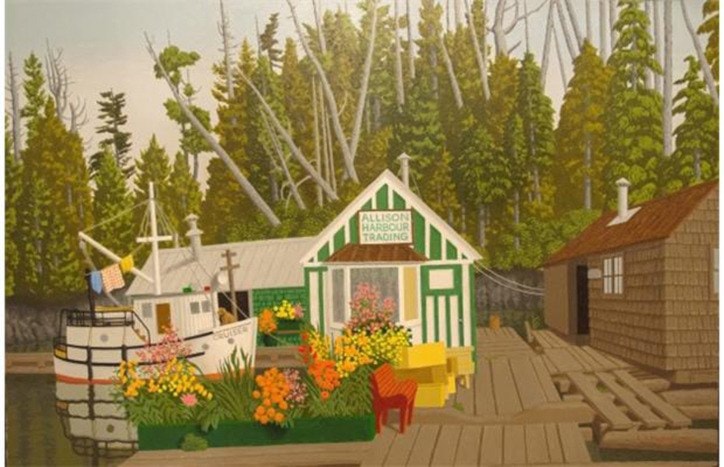Allison Harbour lies across Queen Charlotte Straight, near the entrance to Nakwakto Rapids, at the entrance to Seymour Inlet. It is within the traditional territories of the ’Nakwaxda’xw Nation.
In the early 1900s Seymour Inlet was a busy place for hand-loggers, with small camps dotting the inlet. Steamships and barges preferred not to negotiate the tidal rapids, one of the highest flows of tidal exchange in the world, and protected Allison Harbour became an important transportation hub.
Originally called False Bay, or False Schooner Passage, Allison Harbour was officially named after a coastal logging entrepreneur, A.P. Allison in 1950. It had been known by that name since the 1920s.
In 1924 a detailed marine survey was done of Allison Harbour and an official chart released. This was important due to the reefs which posed a hazard to ships entering the cove.
A post office was established in the Harbour in 1927, and the float community also became a steamship stop, serviced by the Union Steamship Company vessel Chelosin (colloquially known as the “Charlie Olsen”). In the late 1920s Mr. and Mrs. Bellam operated a bunkhouse in Allison Harbour. A small café also operated in the area. In 1937 Percy Sutherland was appointed the local commissioner for the provincial election.
Vic and Melva Eckstein moved to Allison Harbour in 1947 to take over the post office, store and a marine service station. They later added a sawmill to the operations. All of the buildings were on floats. They, and an old trapper, were the sole occupants of the harbour for many years. They were always optimistic that a boom was coming for the area; however, in 1954 when float plane service made the Allison Harbour steamship stop obsolete, the Ecksteins moved to Gibsons, and the little community of Allison Harbour began its decent into obscurity.
Well-known Canadian painter E.J. Hughes (1913 – 2007) painted “The Store at Allison Harbour” in 1955. In 2007 the painting sold for $245,700. It is currently owned by collector Jacques Barbeau, and is on display at Micheal Audain’s museum in Whistler.
In 1965 transport companies started delivering freight directly to logging camps in Seymour Inlet, and the last remaining vestiges of the settlement were soon abandoned.
More recently, the provincial government and The Land Conservancy jointly purchased a tract of privately owned land in Allison Harbour, and in 2008 BC approved the ‘Class A’ Allison Harbour Marine Park, which includes 89 hectares of land and 43 hectares of foreshore. It is a part of the larger Ugw iwa’/Cape Caution Conservancy. The management plan states that there are remnants of an old cannery building in Allison Harbour, although I have not been able to find any references stating a cannery was in operation in this location.
Last year UBC Collections used Allison Harbour as an example of a place in BC for which is it very hard to find any historic information, although it is clear that for many years this was a bustling community. If your family has any photos or information on Allison Harbour please contact me.
Brenda McCorquodale is a Port Hardy resident and North Island history enthusiast. If you have any stories or local lore you'd like to share, email her at storeysbeach@gmail.com. A collection of her past articles is available on her blog at undiscoveredcoast.blogspot.ca/.
